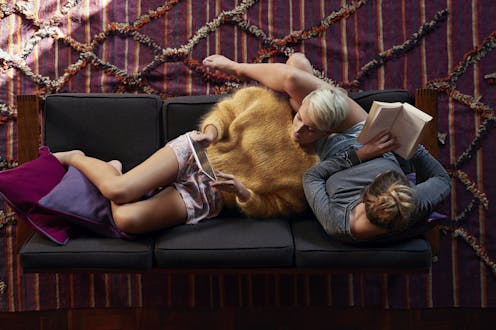What’s behind the astonishing rise in LGBTQ+ romance literature?
- Written by Christine Larson, Assistant Professor of Journalism, University of Colorado Boulder

Initially, big publishers tried to shoehorn digital romance authors into the blockbuster model by acquiring their books and issuing them in print.
That worked for E.L James’ “Fifty Shades of Grey[16],” which started out as fan fiction, was later released by a tiny online publisher and was eventually published by Penguin.
But for LGBTQ+ romance authors, the economics of high overhead, big print runs and a yearlong production schedule simply didn’t work for books geared for presumably smaller audience segments.
As romance readers abandoned mass-market paperbacks for a wider, fresher range of stories, romance editors at large and medium-sized publishers realized they needed to become more like digital presses.
Making love pay
How did they do this?
First, they hired new editors who had cut their teeth at tiny digital publishers with a history of releasing same-sex romance. For our paper, we interviewed several of these editors, including Sourcebooks’ Mary Altman[17] and Angela James[18], founder of Harlequin’s Carina Press. Harlequin has been owned by HarperCollins since 2014.
James, formerly at Samhain, broke sacred publishing rules when she launched Carina, the first digital-only imprint at a traditional publisher. Carina lowered production and distribution costs by publishing only e-books and by offering authors higher royalties but no advances.
The lower-overhead strategy worked so well that in 2020 the imprint created Carina Adores[19], an e-book and print line dedicated to LGBTQ+ romance.
Altman, who had been accustomed to acquiring same-sex romance during her tenure at Ellora’s Cave, continued to do so at Sourcebooks, a mid-sized publisher partly owned by Penguin Random House. In 2020, she released the breakout LGBTQ+ bestseller “Boyfriend Material[20]” by Alexis Hall. Sourcebooks also launched a new imprint, Bloom Books[21], in 2021, which sped up publishing schedules to meet the demands of self-published and other entrepreneurial authors.
These structural changes made romance imprints at large publishers nimbler, more innovative and more open to all kinds of couples.
Ironically, many of these more inclusive stories ended up appealing to mass audiences after all.
“Boyfriend Material[22]” dominated Best Romance of the Year lists in 2020. Adriana Herrera, Alyssa Cole, K.J. Charles and dozens of other authors of LGBTQ+ romance now regularly appear on such lists. “Red White and Royal Blue” is now an Amazon Original movie.
It’s important to note that LGBTQ+ romances still represent only 4% of the print book romance market[23]. Meanwhile, other diverse voices, including Black authors, are still underrepresented[24]. As a whole, the Big Five publishing houses are still adhering to the blockbuster strategy. Nonetheless, the structural changes they’ve made in romance imprints have fostered an outpouring of more diverse love stories.
At a time when other institutions, including universities and businesses, are dismantling programs that support diversity, equity and inclusion[25], the LGBTQ+ romance boom serves as a reminder that inclusion doesn’t “just happen.”
Ongoing social and cultural change requires new systems, processes and structures. Without institutional support, many people won’t get their happy ending.
References
- ^ CC BY-SA (creativecommons.org)
- ^ sales of LGBTQ+ romance grew by 40% (www.circana.com)
- ^ by a jaw-dropping 740% (www.nytimes.com)
- ^ Hallmark Christmas movies (www.msnbc.com)
- ^ Red, White & Royal Blue (www.caseymcquiston.com)
- ^ Payback’s a Witch (www.penguinrandomhouse.com)
- ^ sparkling same-sex historical romance novels (www.goodreads.com)
- ^ recent paper (doi.org)
- ^ Harvard Business School professor Anita Elberse (www.harvardmagazine.com)
- ^ Spare (www.nytimes.com)
- ^ a US$20 million advance (www.dailymail.co.uk)
- ^ Ellora’s Cave (www.publishersweekly.com)
- ^ Samhain (www.publishersweekly.com)
- ^ Big Five (bookscouter.com)
- ^ Richard Baker/In Pictures via Getty Images (www.gettyimages.com)
- ^ Fifty Shades of Grey (www.eljamesauthor.com)
- ^ Sourcebooks’ Mary Altman (read.sourcebooks.com)
- ^ Angela James (www.publishersweekly.com)
- ^ Carina Adores (www.publishersweekly.com)
- ^ Boyfriend Material (www.amazon.com)
- ^ Bloom Books (www.publishersweekly.com)
- ^ Boyfriend Material (read.sourcebooks.com)
- ^ only 4% of the print book romance market (www.nytimes.com)
- ^ are still underrepresented (www.therippedbodicela.com)
- ^ dismantling programs that support diversity, equity and inclusion (www.washingtonpost.com)
Authors: Christine Larson, Assistant Professor of Journalism, University of Colorado Boulder
Read more https://theconversation.com/whats-behind-the-astonishing-rise-in-lgbtq-romance-literature-223159

